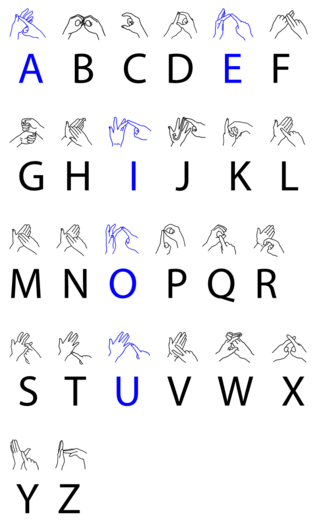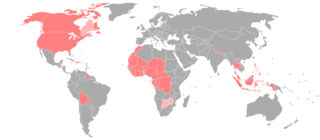Related Research Articles

American Sign Language (ASL) is a natural language that serves as the predominant sign language of Deaf communities in the United States of America and most of Anglophone Canada. ASL is a complete and organized visual language that is expressed by employing both manual and nonmanual features. Besides North America, dialects of ASL and ASL-based creoles are used in many countries around the world, including much of West Africa and parts of Southeast Asia. ASL is also widely learned as a second language, serving as a lingua franca. ASL is most closely related to French Sign Language (LSF). It has been proposed that ASL is a creole language of LSF, although ASL shows features atypical of creole languages, such as agglutinative morphology.

Sign languages are languages that use the visual-manual modality to convey meaning, instead of spoken words. Sign languages are expressed through manual articulation in combination with non-manual markers. Sign languages are full-fledged natural languages with their own grammar and lexicon. Sign languages are not universal and are usually not mutually intelligible, although there are also similarities among different sign languages.
Sutton SignWriting, or simply SignWriting, is a system of writing sign languages. It is highly featural and visually iconic, both in the shapes of the characters, which are abstract pictures of the hands, face, and body, and in their spatial arrangement on the page, which does not follow a sequential order like the letters that make up written English words. It was developed in 1974 by Valerie Sutton, a dancer who had, two years earlier, developed DanceWriting. Some newer standardized forms are known as the International Sign Writing Alphabet (ISWA).

British Sign Language (BSL) is a sign language used in the United Kingdom (UK), and is the first or preferred language among the Deaf community in the UK. Based on the percentage of people who reported 'using British Sign Language at home' on the 2011 Scottish Census, the British Deaf Association estimates there are 151,000 BSL users in the UK, of which 87,000 are Deaf. By contrast, in the 2011 England and Wales Census 15,000 people living in England and Wales reported themselves using BSL as their main language. People who are not deaf may also use BSL, as hearing relatives of deaf people, sign language interpreters or as a result of other contact with the British Deaf community. The language makes use of space and involves movement of the hands, body, face, and head.
Auslan is the majority sign language of the Australian Deaf community. The term Auslan is a portmanteau of "Australian Sign Language", coined by Trevor Johnston in the 1980s, although the language itself is much older. Auslan is related to British Sign Language (BSL) and New Zealand Sign Language (NZSL); the three have descended from the same parent language, and together comprise the BANZSL language family. Auslan has also been influenced by Irish Sign Language (ISL) and more recently has borrowed signs from American Sign Language (ASL).

Deaf culture is the set of social beliefs, behaviors, art, literary traditions, history, values, and shared institutions of communities that are influenced by deafness and which use sign languages as the main means of communication. When used as a cultural label especially within the culture, the word deaf is often written with a capital D and referred to as "big D Deaf" in speech and sign. When used as a label for the audiological condition, it is written with a lower case d. Carl G. Croneberg coined the term "Deaf Culture" and he was the first to discuss analogies between Deaf and hearing cultures in his appendices C/D of the 1965 Dictionary of American Sign Language.
Signing Exact English is a system of manual communication that strives to be an exact representation of English vocabulary and grammar. It is one of a number of such systems in use in English-speaking countries. It is related to Seeing Essential English (SEE-I), a manual sign system created in 1945, based on the morphemes of English words. SEE-II models much of its sign vocabulary from American Sign Language (ASL), but modifies the handshapes used in ASL in order to use the handshape of the first letter of the corresponding English word.

Irish Sign Language is the sign language of Ireland, used primarily in the Republic of Ireland. It is also used in Northern Ireland, alongside British Sign Language (BSL). Irish Sign Language is more closely related to French Sign Language (LSF) than to BSL, though it has influence from both languages. It has influenced sign languages in Australia and South Africa, and has little relation to either spoken Irish or English. ISL is unique among sign languages for having different gendered versions due to men and women being taught it at different schools.

South African Sign Language is the primary sign language used by deaf people in South Africa. The South African government added a National Language Unit for South African Sign Language in 2001. SASL is not the only manual language used in South Africa, but it is the language that is being promoted as the language to be used by the Deaf in South Africa, although Deaf peoples in South Africa historically do not form a single group.
Indo-Pakistani Sign Language (IPSL) is the predominant sign language in the subcontinent of South Asia, used by at least 15 million deaf signers. As with many sign languages, it is difficult to estimate numbers with any certainty, as the Census of India does not list sign languages and most studies have focused on the north and urban areas. As of 2021, it is the most used sign language in the world, and Ethnologue ranks it as the 151st most "spoken" language in the world.
A contact sign language, or contact sign, is a variety or style of language that arises from contact between deaf individuals using a sign language and hearing individuals using an oral language. Contact languages also arise between different sign languages, although the term pidgin rather than contact sign is used to describe such phenomena.
The legal recognition of signed languages differs widely. In some jurisdictions, a signed language is recognised as an official language; in others, it has a protected status in certain areas. Although a government may stipulate in its constitution that a "signed language" is recognised, it may fail to specify which signed language; several different signed languages may be commonly used.

Mexican Sign Language, is a natural language that serves as the predominant language of the Deaf community in Mexico. LSM is a complete and organized visual language, which is expressed with the hands, face, and body, with its own distinct history, community, and culture. There are several dialects based on regional variation and LSM may be learned as a second language by hearing and Deaf signers. LSM is closely related to French Sign Language (LSF) and American Sign Language (ASL), although it is mutually unintelligible.
Television Malta is a terrestrial television network in Malta operated by the national broadcaster, Public Broadcasting Services. TVM broadcasts a sister channel, TVM 2.
Maltese literature is any literature originating from Malta or by Maltese writers or literature written in the Maltese language.
Filipino Sign Language (FSL) or Philippine Sign Language, is a sign language originating in the Philippines. Like other sign languages, FSL is a unique language with its own grammar, syntax and morphology; it is neither based on nor resembles Filipino or English. Some researchers consider the indigenous signs of FSL to be at risk of being lost due to the increasing influence of ASL.
Claire L Ramsey is an American linguist. Ramsey is an Associate Professor Emerita at the University of California, San Diego. She is an alumna of Gallaudet University and is former instructor at the University of Nebraska in Lincoln, Nebraska. Ramsey's research has focused on the sociolinguistics of deaf and signing communities in the US and Mexico.

American Sign Language (ASL) developed in the United States and Canada, but has spread around the world. Local varieties have developed in many countries, but there is little research on which should be considered dialects of ASL and which have diverged to the point of being distinct languages.

The Deaf rights movement encompasses a series of social movements within the disability rights and cultural diversity movements that encourages deaf and hard of hearing to push society to adopt a position of equal respect for them. Acknowledging that those who were Deaf or hard of hearing had rights to obtain the same things as those hearing lead this movement. Establishing an educational system to teach those with Deafness was one of the first accomplishments of this movement. Sign language, as well as cochlear implants, has also had an extensive impact on the Deaf community. These have all been aspects that have paved the way for those with Deafness, which began with the Deaf Rights movement.
TVMNews+ is a terrestrial television network in Malta, operated by national broadcaster Public Broadcasting Services. Unlike the more wide-ranging TVM network, TVMNews+ focuses primarily on newscasting and educational television.
References
- Notes
- ↑ Maltese Sign Language at Ethnologue (18th ed., 2015) (subscription required)
- ↑ Gatt, Albert (2018). The languages of Malta. ISBN 9783961100705.
- ↑ Galea, Maria (2014). SignWriting (SW) of Maltese Sign Language (LSM) and its development into an orthography: Linguistic considerations (Ph.D. dissertation). Malta: University of Malta. Retrieved 4 February 2015.
- ↑ Vella, Matthew (5 March 2012). "PBS takes Education 22 in cultural revamp of station". MaltaToday. Retrieved 23 February 2016.
- Bibliography
- Marie Azzopardi-Alexander, "Iconicity and the development of Maltese Sign Language", in Fabri, ed., Maltese Linguistics: A Snapshot, 2009